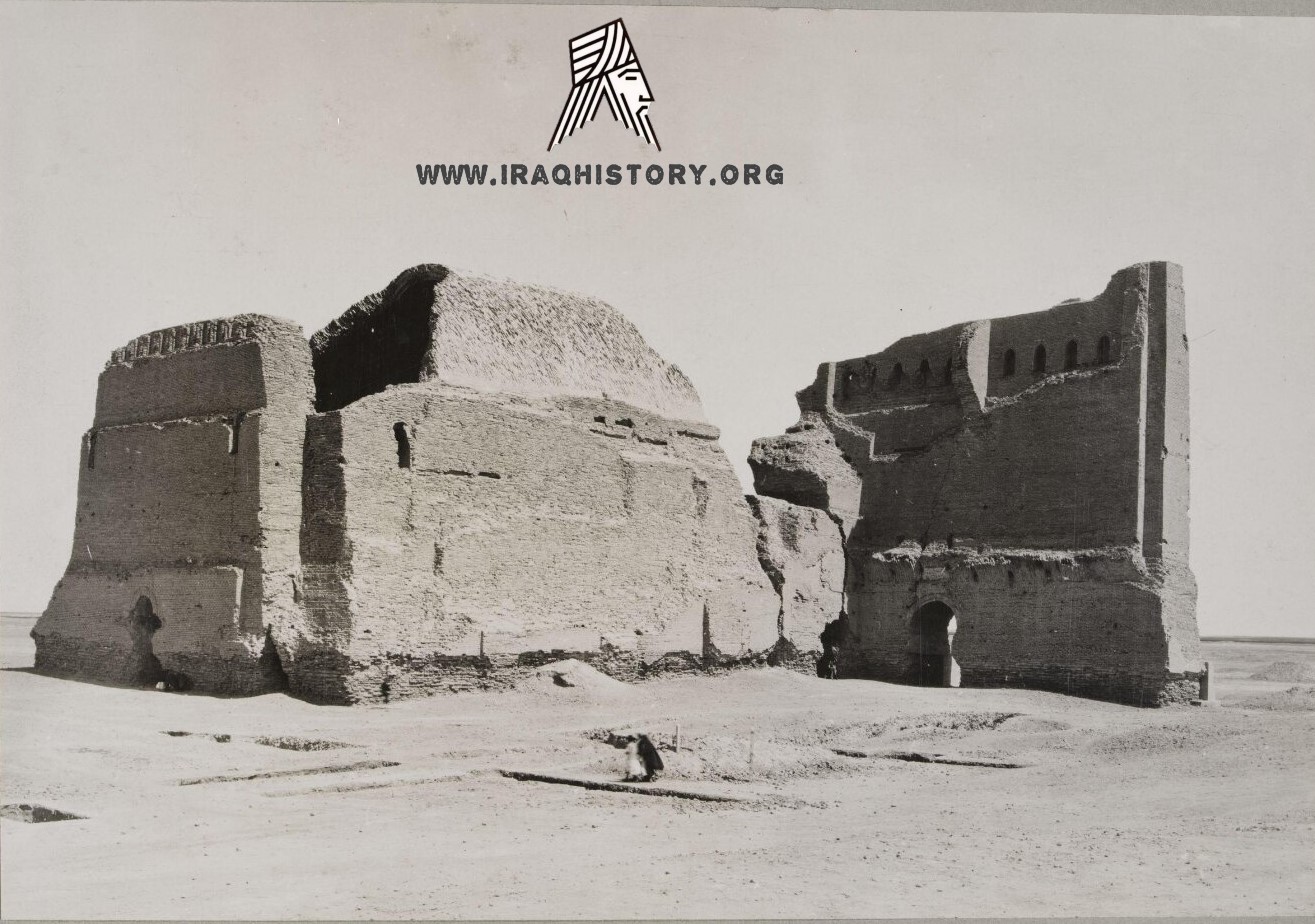THE SASSANIAN PERIOD
(226-637 A.D.)
Ardashir (226-241 A.D.), was the son of of Babek and the grandson of Suman, fr whom the dynasty is named. During the Parthian period the rulers had been hig constantly to protect their throne not only against the outward enemies me Romans, but also against revolt from within their realm. Such a revolt was headed by Ardashur, founder of the Sassanian Dynasty, who rebelled against bis Parthian overdent Artabanus V. He advanced on the provinces of Fars, subduing them and when Artabanus was forced to take the field against him he defeated the Parthian army and killed Artabanus himself (226 A.D.) Within the space of two years from them Ardashir not only won the rest of Artabanus’ empire over to himself, but even enlarged ita limits to reach the Euphrates. He took over Ctesiphon as his winter residence, and despite several serious attempts by Parthian princes to recover their lost dominions. be held his throne steadily.
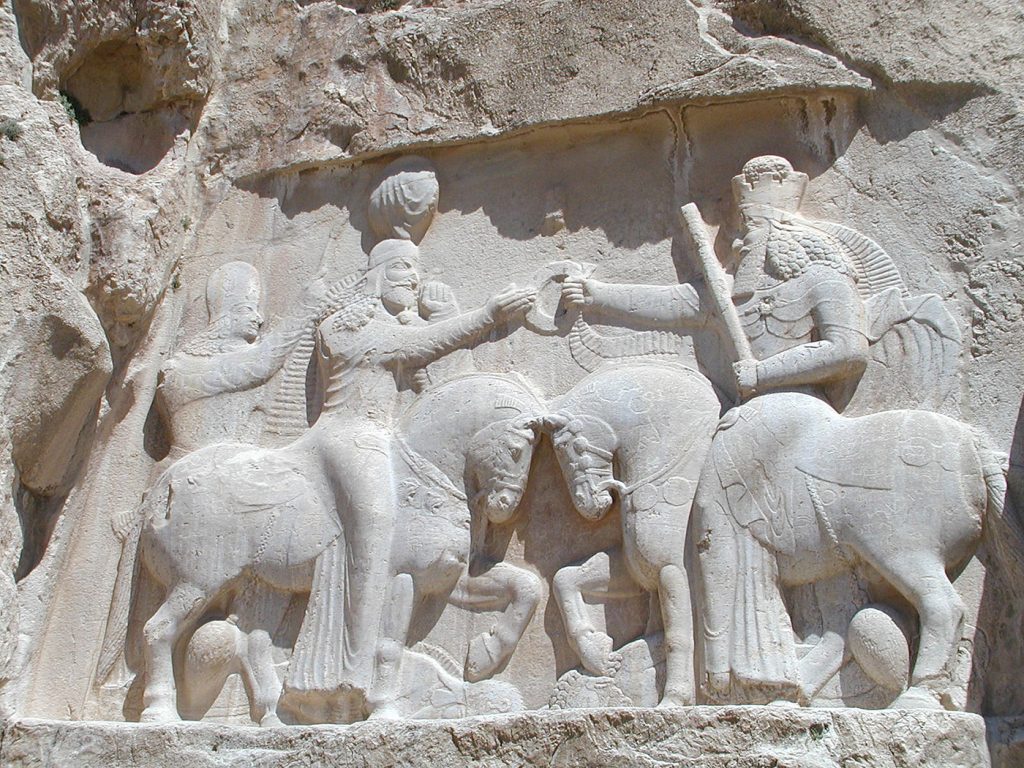
Investiture of Ardašir I. 224–241. Creator: Jona Lendering.
Sapor (Shapur) I (241-272 A.D.) succeeded his father on the throne, and justly deserves his considerable reputation. He founded a regular disciplined army and setting out to conquer the lands east of Iran gained many important victories. After also duing the provinces and petty rulers in the north, he turned to Syria with the object of opposing the Romans. Marching through the country, he reached Antioch without encountering any serious opposition, and there he imposed tribute on the Roma generals. However, the period of peace was soon terminated by Sapor himself when be carried his offensive into Roman territories during the reign of the Roman Emperor Valerian. A fierce battle resulted at Edessa (Urfa), which ended in a complete victory for the Sassanian forces. Sapor advanced to Antioch, at that time the capital of the Roman Empire in the Near East, and he took and plundered the city. This victory he per petuated by narrative sculptures which are still to be seen on the rocks of Fars. None theless, on their return march, the Sassanian army suffered losses at the hands of the ruler of Palmyra, Odenathus, whose proffered peace-offerings Sapor had turned down This confrontation (265 A.D.) occasioned much loss in men and materials to the Sasanian army, and a large portion of the booty carried off from Antioch fell into the hands of Odenathus. As a result of these achievements of Odenathus, his reputation was greatly enhanced, and the Romans bestowed on him the honorific title of dux orientis “ruler of the East”. After his death this title was inherited by his famous wife Zenobia (Arabic: al-Zabba), a beautiful queen who proved to be a worthy successor and played a signif cant role in the politics of that time (270 A.D.). She defied the Roman Empire, and extended the frontiers of her kingdom until they included all Syria and as far as Alexan dria. In the East she fought Sapor, and pursued him to walls of Ctesiphon. However, a sad fate awaited the proud Arab queen: the troops of Aurelian defeated her armies in two crucial battles, and laid siege to her capital Palmyra (272 A.D.). In the end Aurelian entered the city and took the queen captive.
Palmyra itself is situated in the Syrian Desert, and was another important strategic , which controlled the trade routes and occupied a position between the two great city
opposed empires of the time, the Sassanian in the East and the Roman-Byzantine Empire of the West. The Palmyrans, who were mainly Arabs, boasted a thriving civilization of their own, which shows much Hellenistic influence. The architectural remains of the huge temples and monumental stone buildings, still to be seen at Palmyra, are a living testimony to the city’s one-time greatness and affluence.
The reign of Sapor I was a prosperous and golden era, in which the arts and sciences Bourished and spread. The celebrated Mani, founder of the Manichaean faith, lived dur ing his reign, and the magnificent Arch of Ctesiphon, to some scholars, could be attributed to him. After his death, the throne was held by a succession of rather weak kings, and the empire appeared in such internal disorder that the Romans were encouraged to take advantage of the situation and open hostilities intermittently. Another thorn in their side were the Arab tribes of the desert, chief among which were the Ghassanids who had settled in the Wadi Hauran, south of Damascus. The Ghassanids, especially their chiefs Harith bin Jabla and al-Mundhir bin al-Harith, were of great assistance to the Byzantine emperors in their wars against the Sassanians. They developed their own cultural and architectural traditions, and were a strong influence on the borders of the desert, es- pecially in the introduction of Christianity which they wholeheartedly embraced.
Sapor II (Dhul-Aktaf) reigned for seventy years, from 310 to 379 A.D. During his glorious reign, which put an end to the period of decline into which the Sassanian Empire had sunk, he engaged the Romans conflict on several occasions. At the battle of Sinjar be met and defeated the Emperor Constantinus II, and was subsequently able to take over many of the Roman forts and citadels scattered throughout the North. At this date the Roman empire adopted Christianity. In the North Sapor’s army in the meantime subdued large areas, and converted Cushania from an independent principa lity to a province of his empire. Eastwards also he extended his rule, and spread Sassan- ian culture far into Turkestan and China, While Sapor was engaged with his eastern pro- vince, the famous Roman emperor Julian ascended the throne, and assembling a large army set out to restore the empire’s fortunes in the East. The Roman army occupied Nisibin and other cities on the Euphrates, and marched down into Babylonia to the wall of Ctesiphon. After hearing of the plight of his capital, Sapor mobilised his army and advanded to meet the invaders.
The two armies met in a fateful battle near the Jebel Hamrin, in which Julian met his death and the Roman army suffered a terrible defeat. The Romans, weakened by heavy losses of life and materials, retreated to Antioch, and as a result Sapor was able to regain control not only of Mesopotamia, but also the city of Nisibin and the northern provinces including Armenia.
During Sapor’s long reign, the Sassanian empire remained powerful, but on his death court intrigues broke out over the succession, and there followed a line of weak kings. Another reason for the decline of the Sassanan supremacy was religious dissension. Christianity gained ground in northern Mesopotamia and Armenia, notably during the reign of Yazdegerd, in 4th and 5tr benturies A.D., while sectarian troubles greZoros between the followen 4th and 5th centuries as Manichaeism, Mazdakism, and Zoros-
traniem, ar well as Christianity, Mazdakism in particular was widespread, with its ideas vocaling fraternitynity. Maydaking classes which were derived from Mater cheen. Kobad 1 1483-49d equality among claichean principles at one time, but Inter turned against them.
About this time, during the 3rd century AD., the Arab Lakhmid Manadhira king dom had its genesis at Hira, and it remained a power until the advent of Islam. Hira lies on the fringes of the desert near the Euphrates in Iraq, and towards the end of the Parthian period was a center for the Arab Tannukh tribe, who Aday followed as Judhaima al periach. He was succeeded by the Lakhmid Amru bin Aday, followed by his son Umu Al-Qais and after him al-Nu’man who was renowned for his construction of the palaces al Qa Kawarnaq and as-Sadir. Then followed al-Mundhir ibn al-Nu’man (520 A.D.) who was nicknamed Abu Qabus and was killed by the Sassar tribes) Cougar mies under the command of Hani bin Mas’ud al-Shibani (of the Bani Bakr tribes) fought the Sasanians in the battle of Dhi Qar near Nasiriyah, and achieved a complete victory. About 25 Arab kings ruled at Hira, with authority stretching across the Arab Peninsula and into the Syran Desert, and siding with the Sassanians against the Byzantines and the Ghas sanids. Placed between the Sassanians on one side and the desert on the other, this king- dom did much to transmit culture and promote trade from and to Arabia.
Chosroes I (Anushirwan) (531-579 A.D.) was the king who resccued the Sassanian Empire from its decline, and after his accession he introduced great reforms in the nancing and managing of the state, in the reorganisation of the army, and in education. and he encouraged the translation of Greek and Indian books on medicine and science. During his reign of half a century he reconquered Antioch and defeated the Byzantine armies in Armenia. In 540 A.D. he undertook the restoration of the famous Arch of Ctesiphon (Taq Kisra). He was again followed by a number of weak kings, until the reign of Chosroes II. Chosroes II (Parvez) (590-628 A.D.) proved himself an indefatigable and determined
warrior, whose reign was marked by continual and successful conflicts with the oppon ents of the Sassanian Empire. Among his considerable achievements are the invasion of Egypt, the occupation of Asia Minor, and the siege he imposed on Constantinople tself, to which no other Sassanian ruler reached. However, the Prophet Muhammad is reported to have sent a letter to Chosroes.
calling upon him to enter the faith of Islam, but he refused, being enraged at the request to abandon the religion of his fathers. He led a life of luxury and self-indulgence, and it may be that his arrogance and his abandonment to pleasures brought on him the great reverses which characterised the later years of his reign. The Byzantine emperor Heraclius led his armies into the East, driving the Sassanian from Asia Minor, and swooped down the Tigris. After a siege, the Byzantine armies took Ctesiphon itself, and Chosroes was put to death. In the course of a few years all the foreign conquests of Chosroes were lost. There followed in Persia a period of internal dissension due to the scheming interference of the nobles and mobads (high priests), and none of the succeeding kings ruled for longer than one year.
Yazdegerd III (632-651 A.D.) came to the Sassanian throne at a time when the empire was rapidly heading towards its doom. During the reign of this last Sassanian king the empire was again torn by internal divisions and a mere serious threat was the presence of the Arab Muslim armies which were now campaigning in Syria and Iraq. At the battle of Yarmuk the Byzantines were decisively routed. and the Arabs followed the retreating forces into Asia Minor. In 637 A.D. the Muslims gained a decisive victory over the Sassanian armies of Yazdegerd III at the Battle of Qadisiyah, near Hira in Iraq. The Mus lim general, Saad ibn Abi Waqqas, put the Sassanian general Rustam to flight and forced
his way at the head of the Muslim armies into Ctesiphon, thus ending for ever the Sassan.ian domination of Iraq. However, the fight against the Sassanian was not yet over, andit was carried into Persian territory proper, where they were finally crushed at the greateRattle of Nihavend. Yazdegerd himself fled from the field, but was killed (651 A.D.). Sodid the Sassanian Empire come to its end. and the Arab Islamic rule of the Near Eastbegan.
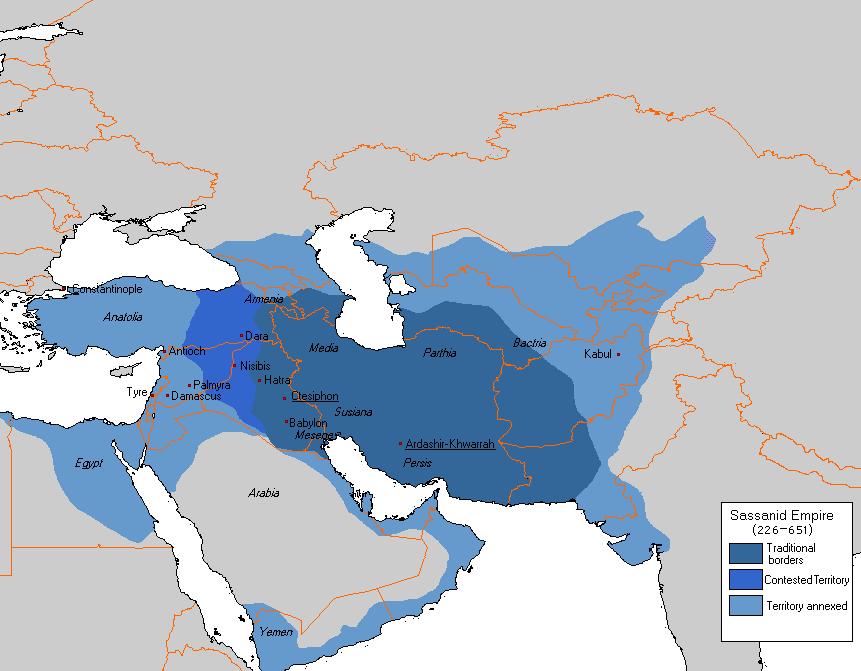
Sassanid Map. Author: Arab League. 26 January 2008.
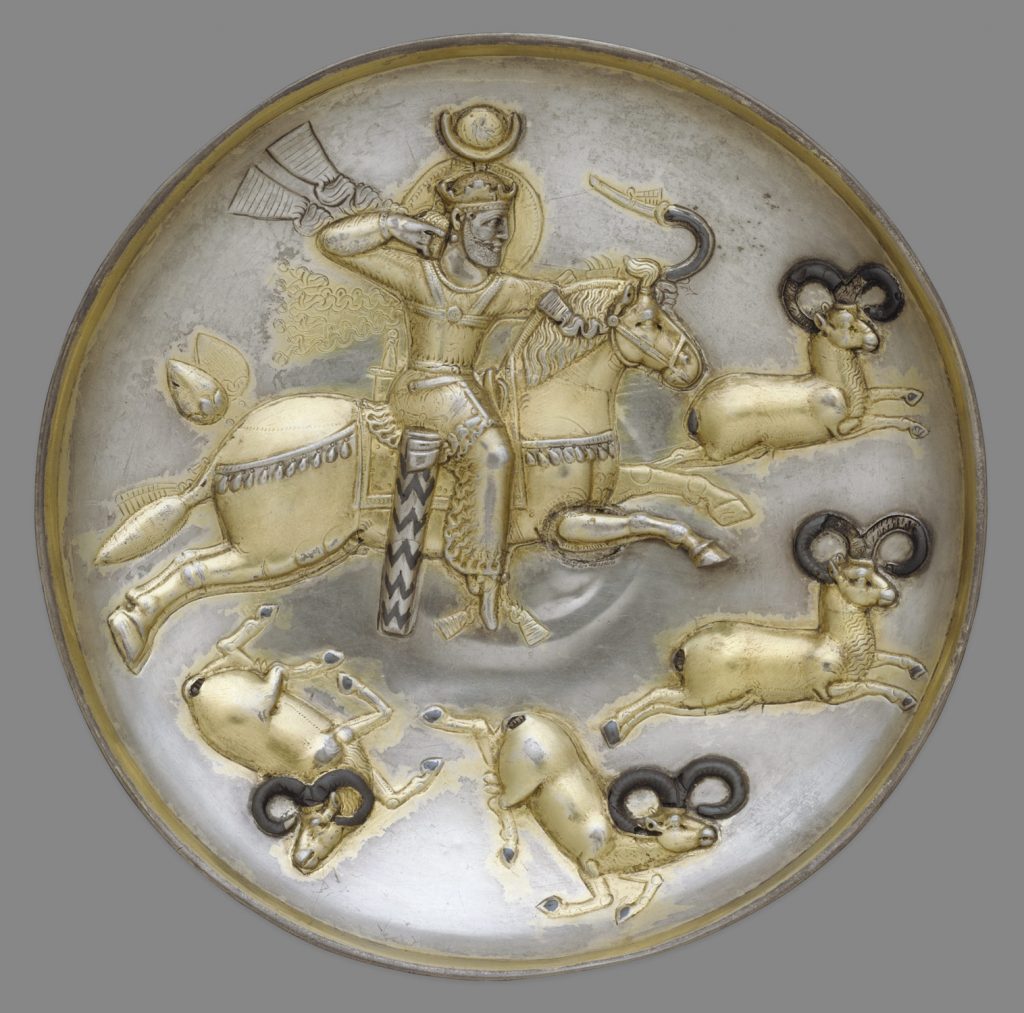

Plate with king hunting rams, A.D. mid-5th–mid-6th century, Silver, mercury gilding, niello inlay, Accession: 34.33 On view in: Gallery 405, The Metropolitan Museum of Art
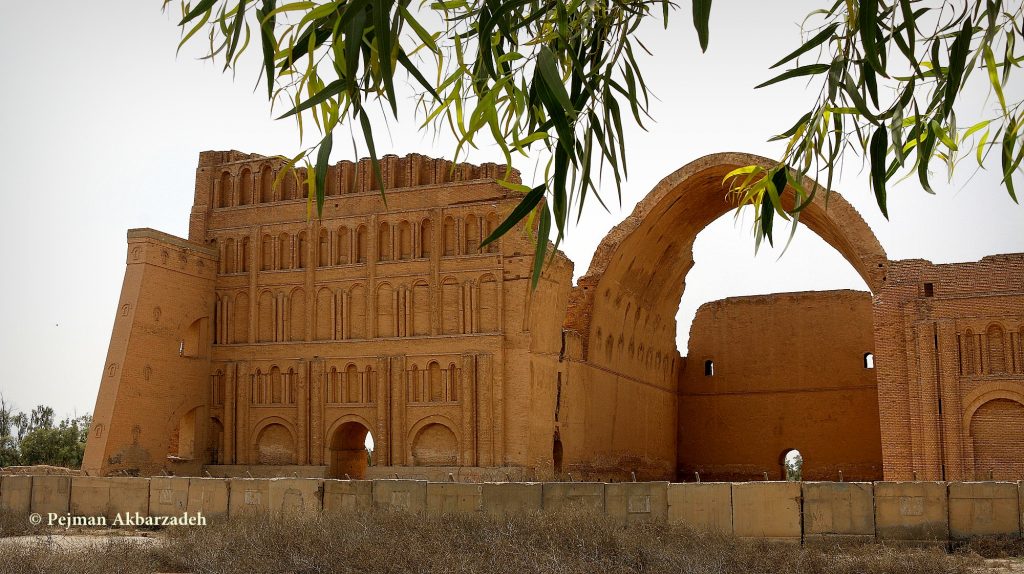
Taq-i Kasra, one of the ancient world’s largest arch from the Sasanian capital city of Ctesiphon, a few miles from the modern Iraqi capital city of Baghdad. © Pejman Akbarzadeh.


